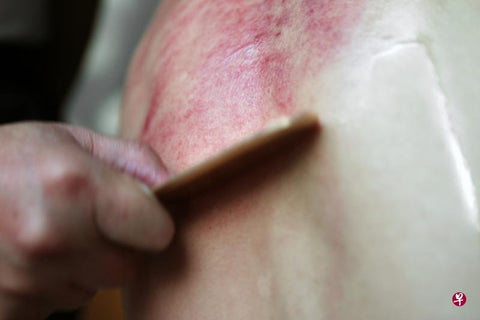
Gua Sha: Here's Everything You Need To Know
As a local, born-and-raised Hong Konger, I grew up surrounded by Traditional Chinese Medicine, seeing treatments such as herbal medicine, tuina and cupping therapy without the air of skepticism that it is often met with in Western society. While, today, these are usually referred to as 'alternative treatments', it would be prudent to remember that this was the prevailing form of therapy available here, developed over many years and generations, until the advent of modern medicine.
Gua sha, a traditional Chinese treatment with millennia of history behind it, has found new spotlight in Western media. Recent years have seen smooth, gem-stone tools sold on different lifestyle and wellness platforms—but ...
What Is Gua Sha, Anyway?
'Gua' is 'to scrape' and 'sha' refers to the sicknesses that reveal themselves as red, spotty marks when the treatment is performed. This involves repeatedly scraping the skin with a massage tool and traditionally was used to treat heatstroke and common colds, but also boasts benefits of reducing inflammation, improving circulation and providing pain relief. Eastern medicine subscribes to the belief that elements such as heat, cold, wind and damp can be trapped in the body and—in this context—gua sha aims to restore the optimal balance by removing excess coldness or toxic heat.
A precursory search on Google Images would have you believe that gua sha is a facial treatment performed in a spa or at home, but traditionally it is performed around the neck and back, leaving angry-looking red marks in its wake, often by a middle-aged man wielding little more than a porcelain spoon and some form of lubricant, be it massage oil or lotion.

The facial treatment counterpart of gua sha typically does not leave these bruise or rash-like markings (actually petechiae, tiny bleeds from capillaries), which perhaps has made the treatment more palatable in the West, especially considering the touted advantages of improved circulation and lymphatic drainage that go on to clear up skin and reduce wrinkles.
Benefits of Facial Gua Sha
As the treatment manually helps to drain the lymphatic system (which can cause puffiness and inflammation), people noticed slimming and lifting results with fewer wrinkles on their face. Reduced tension (especially in the jaw area) and brighter skin were also reported.
How to Gua Sha
Facial gua sha should be done on a freshly washed face prepped with some facial mist and oil or lotion—it shouldn't be too slippery, but just enough that the tool can slide over the skin smoothly. The tool should not be held perpendicular to the skin, but pulled almost flat against the face, in upward and outward motions starting from the neck, with light to medium pressure.
Those looking to try it can look to YouTube for guides—here is one that is thorough in its explanation of how to hold the tool and where to press.
While massage tools made of stones such as jade and rose quartz can be readily found in both Eastern and Western markets, one should always be cautious when using tools made of porous minerals such as jade. Its porosity leaves it prone to harbouring bacteria, so they should always be cleaned before and after each use, whether with warm water and soap or wiped down with alcohol. Do not, however, boil the stones as they may behave unpredictably and explode in boiling water!
Another material we have curiously seen pushed by bloggers is “ice cube gua sha”, as well as the preparation of keeping your gua sha tools in the fridge or freezer. We can theoretically understand the train of thought and intention here—ice or cold compresses are often used to reduce inflammation and swelling—however, the use of ice directly contradicts the intention of drawing out excess coldness.
Receiving gua sha here in Hong Kong, the therapist is sure to end the session by instructing you not to bathe within the following 1-4 hours (cold showers should be avoided for the next 24!), not to have cold or iced drinks and to avoid air-conditioning. You are more vulnerable to ‘cold’ sneaking back into your body in the period immediately following the process of gua sha, so these sources of entry should be shut off, at least for the few hours after your session. Otherwise, the therapeutic effect would be disrupted by the introduction of coldness.
It's worth noting that those taking blood thinners or with clotting or cardiac disorders should steer clear of this treatment or, at the very least, consult a doctor and a practitioner before trying it. It also should not be performed on babies (under one year old), pregnant women, cancer patients or diabetics, or on broken skin or active acne breakouts. Any new oils or lotions should also be patch-tested (on the wrist or behind the ear is a good place to do so) before use to rule out allergies!
*note from Taylor: I tried it recently with a new oil and after two days my skin was inflamed with tiny bumps everywhere, showing I had an allergic reaction to it. Be sure to take extra caution as a beginner and really test out any new oils!
While it is always nice to see Asian heritage become more accepted and celebrated in the West, we also hope that the theories and traditions behind these ideas are observed and taken into account, too. There is, however, a very welcomed increase in willingness to research and methodically study this form of therapy, as well as to analyse and critique existing studies.
Have you ever tried gua sha or are you interested to try? What kinds of alternative therapy are you familiar with? Let us know in the comments!

1. Wildling Empress Stone, $65
2. KORA Organics Rose Quartz Heart Facial Sculptor, $58
3. Mount Lai Amethyst Gua Sha Facial Lifting Tool, $34
4. Odacité Crystal Contour Gua Sha Blue Sodalite, $45


